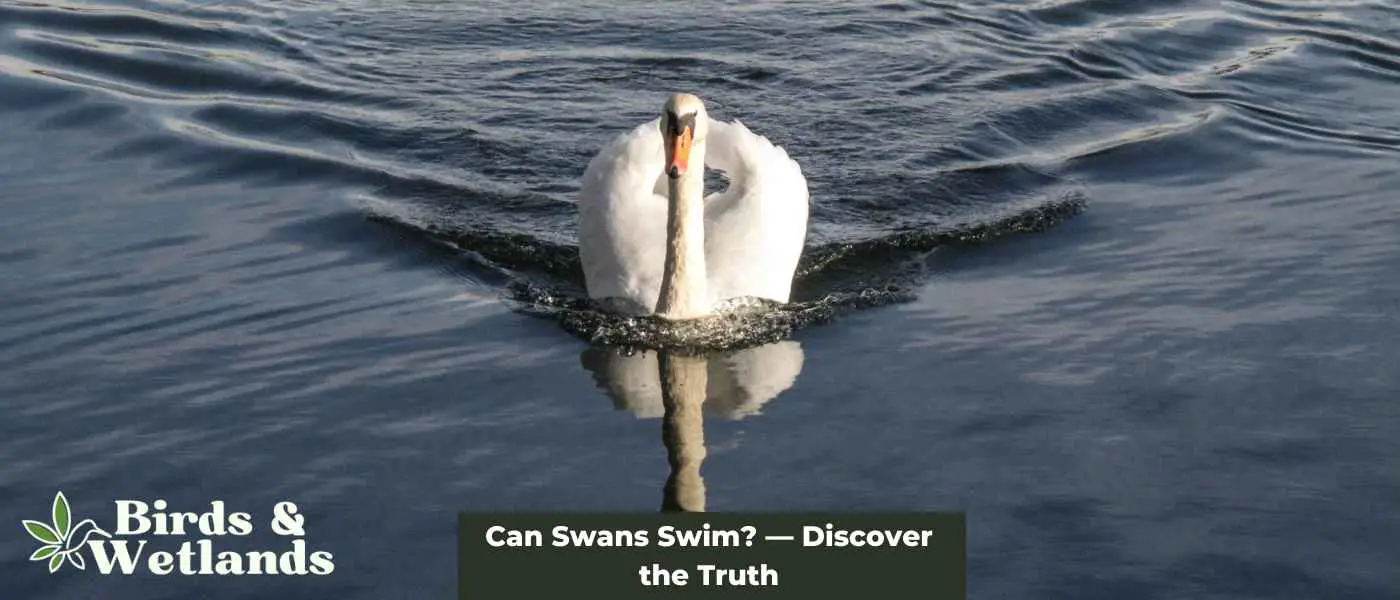Swans are large waterbirds that prefer to live in wetland habitats, such as marshes, swamps, and shallow lakes. They are often found near the freshwater and salt water, relying on it for food and nesting sites.
Swans are excellent swimmers and are known to spend much of their time in the water. Their large webbed feet and strong wings make them well-suited for swimming and navigating the water.
The fact that swans live near water and prefer wetlands indicates their natural swimming ability. They can swim long distances and even dive underwater to forage for food.
Key Takeaways on Can Swans Swim
- Swans are excellent swimmers, capable of swimming long distances and diving underwater to forage for food.
- Swans have webbed feet and strong wings that help them move through the water quickly.
- Swimming is an important part of a swan’s survival as it allows them to escape predators, find food, and travel during migration.
Are swans good at swimming?
Swans of the northern hemisphere are known to be excellent swimmers. They have webbed feet and strong, powerful bodies that allow them to move through the water easily. These waterfowl can use their wings for propulsion, which helps them to swim faster and more efficiently.
Swimming is an important aspect of a swan’s survival. It allows these birds to escape predators, find food, and travel during migration. Swans can swim in fresh and saltwater and occasionally dive underwater to search for food.
When it comes to escaping predators, swans can use their strong swimming abilities to escape danger quickly. They can outswim many of their natural predators, such as raccoons and foxes. Additionally, swans can use their size and strength to defend themselves against potential predators.
Swans are also able to use their swimming abilities to forage for food in fresh water and sea water habitats. They eat mostly aquatic plants, fish, amphibians, mollusks and invertebrates.
Swans use their long necks when feeding underwater and for grabbing food that is out of reach. Some swans, such as the black swan, occasionally dive underwater to search for food.
Lastly, swans use their swimming abilities and flying to travel during migration. They can cover large distances in the water and navigate different bodies of water. During their annual migrations, swans use wetland habitats as stopover points to recharge and rest.
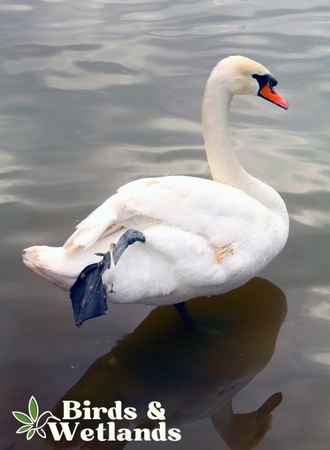
What helps a swan to swim in water?
A swan can swim in the water thanks to its webbed feet. The webbed feet have a wide, flat shape that allows the swan to move easily through the water. The webbing on the feet also helps the swan to maneuver in the water and change direction quickly.
In addition to its strong feet, a swan also has a strong and powerful set of muscles in its legs and wings. These muscles help the swan paddle through the water and maintain balance. The swan’s wings also help to propel it through the water, similar to how a boat’s oars are used to move the boat.
Can swans swim underwater?
Swans don’t usually swim underwater. When they forage food, they do what’s called “up-ending” and dabble on water surface.
However, some swans dive underwater, albeit only for a few seconds. Black swans have been observed diving underwater for 5 to 10 seconds while swimming on southern Australia’s coasts.

Do swans swim with 1 foot?
Swans do not swim with just 1 foot. They use both of their feet to swim. The feet of a swan are webbed, which helps it to move easily through the water. The swan will paddle both feet simultaneously, with the wings also helping propel it forward.
When a swan is on land, it will often stand on one foot. Swans can regulate their body temperature by changing the blood flow to their feet. When a swan stands on one foot, it can warm the other foot by tucking it close to its body.
Do swans paddle under water?
Yes, swans do paddle underwater. Swans can use their webbed feet to move through the water and search for food. They can also use their wings to help them maneuver and propel themselves through the water. This allows them to find food and escape predators.
For example, a mute swan may paddle underwater to find aquatic plants to eat or to escape from a predator like a fox or a raccoon. They can also search for fish and other small aquatic animals to eat. This ability to paddle underwater is one way swans can survive in their natural habitat.
Swans prefer shallow water such as a slow-moving river or lake than deep water but some species live near the coast.

Why do swans swim with feathers up?
Swans such as tundra swans and whooper swans swim with wings arched or feathers up to show off their strength and power. This is done as an aggressive display, emphasizing their size by raising the wings over their backs in a puffed-up position and arching their necks into a strong S-curve.
This behavior can be seen throughout their natural habitat and is an important part of swans’ communication language. By taking an assertive stance on the water, swans can effectively send messages of intimidation or courtship with minimal effort.
How fast do swans swim?
With the use of its webbed feet and short legs, a swan can swim at speeds of approximately 1.6 miles per hour despite having a large body.
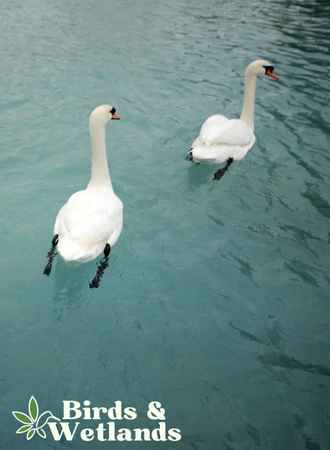
Why do swans put their heads under water?
Swans put their heads underwater to search for food. They use their long necks to reach deep into the water to find plants and small animals to eat. Their beaks are also specially adapted to help them find and grasp food in the water.
Swans also use their heads to search for potential nest materials such as twigs and leaves. They also use their heads to groom themselves and their feathers.
Related Questions About Swans
Do swans sleep on the water?
Yes, most swans can sleep whilst floating on the water. They can balance themselves on one leg while resting the other leg on their back. This ability allows them to stay afloat and sleep at the same time. They can also keep one eye open while sleeping, enabling them to be aware of any potential dangers nearby.
The swan’s long neck can bend so that the head can be pulled back and tucked under a wing, which helps to keep the swan warm and protect the head while the swan is sleeping on the water. This unique adaptation allows swans to survive in their aquatic environment.
Some swans can sleep standing on one leg with their heads tucked under their wings.
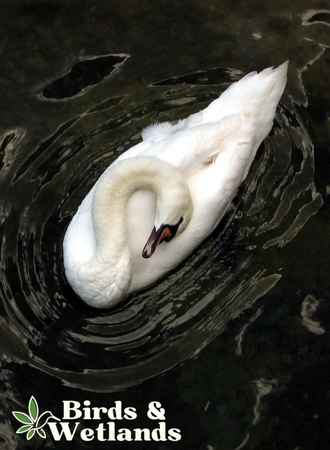
What family do swans belong to?
Swans belong to family Anatidae which also includes ducks and geese.
Do all swans belong to genus Cygnus?
Yes, all swans including the trumpeter swan, tundra swan, whooper swan, mute swan and black-necked swan belong to genus Cygnus and class Aves. The Coscoroba swan of South America is no a true swan and belongs to genus Coscoroba.
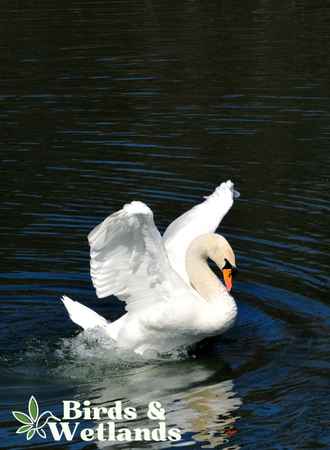
Do swans fly in formation?
Swans do not typically fly in formation. They are more likely to fly alone or in small groups. However, during migration in the winter months, swans may fly in a V-shaped formation, which helps them to conserve energy and navigate more efficiently. This formation is also known as line abreast formation.
Do swans mate for life?
Swans, particularly mute swans, have long been believed to be a traditional symbol of lifelong love and commitment, with many assuming that the birds stay together for life. However, this is not always the case as some species are known to stay together for only one mating season, or even less.
Swans who don’t find a mate during one season may be able to find one the following year, making them far less monogamous than commonly thought.
Swans that form life-long bonds find a new mate when a mate dies.
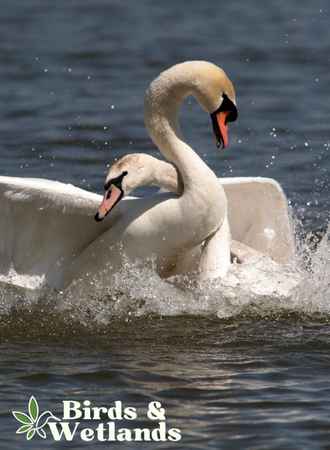
How many eggs do female swans lay?
During the breeding season, swans typically lay three to eight eggs per clutch. The female will then incubate her eggs for approximately 35 days while her mate stands guard nearby. On rare occasions, female swans (called pens) can also lay up to eleven eggs and sometimes even as few as one or two.
Baby swans, called cygnets, are born with mottled gray down plumage and are looked after by the female and male swans (called cobs).
Do swans have black feathers?
Most swans have white feathers and a black bill (orange bill in the case of mute swans). But the Australia’s black swan has black feathers while the black-necked swan has a white body but black neck and head.

